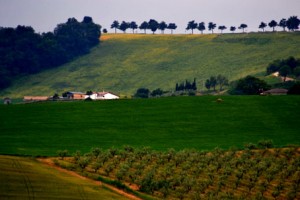 So let’s begin with a short geography lesson. Abruzzo is a wild and woolly region half way down Italy’s booted leg. It straddles the Apennine mountains east of Rome and west of the Adriatic. Largely industrial, it also has a wealth of small agricultural land-holdings that primarily produce saffron, licorice, olive oil and wine.
So let’s begin with a short geography lesson. Abruzzo is a wild and woolly region half way down Italy’s booted leg. It straddles the Apennine mountains east of Rome and west of the Adriatic. Largely industrial, it also has a wealth of small agricultural land-holdings that primarily produce saffron, licorice, olive oil and wine.
Abruzzo, true to form, has an industrial approach to wine making, and almost eighty percent is produced by large co-operative wineries, many of which sell wine to Italian and French winemakers for blending.
Montepulciano is the most popular grape in the region, which produces wines with strong colour but gentle tannins. Montepulciano wines are best when youthful and accompanied by food (isn’t is so often the case with Italian food and wines, which – to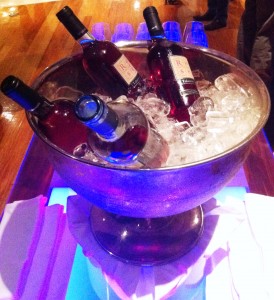 paraphrase Frank Sinatra – go together like love and marriage).
paraphrase Frank Sinatra – go together like love and marriage).
Cerasuolo, a rosé made from Montepulciano grapes, is a speciality of the region. Cherry coloured, with a spicy aroma, Cerasuolo tastes of cherry and orange peel, strawberry and cinnamon and is described by wine experts as “one of the world’s great rosés”.
The Talamonti Cerasuolo rosé is certainly a delightful wine, and cheerfully accompanies a variety of dishes. We first made its acquaintance in the foyer of the EDSA Shangri La last week, where, with wine on our minds, we had gathered for ‘cocktails,’ before attending another lovely dinner hosted by the Wine Depot and Talamonti at ‘Paparazzi’. (No, unfortunately I wasn’t sipping wine in the late summer sunshine in Italy, maybe next time!) This lightly fruity rosé – melon and raspberries spring to mind – enhanced by a dash of spice, went down very smoothly. It also paired up extremely well with the melon and prosciutto canapés on offer, and conjured up dreams of vines rambling up an Italian hillside .
We eventually settled at our table before a phalanx of glasses, and bowls of fresh, crisp Italian 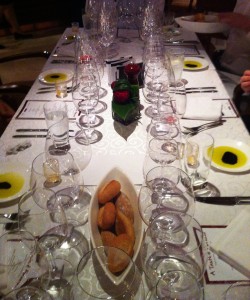 rolls that rapidly disappeared, via side plates daubed with olive oil and vinegar. I have only been to Paparrazzi once before, and I cannot pretend the cooking shone that time, but tonight, with a set menu to match a selection of Talamonti’s best, everything met with our approval. The service was swift and efficient, and the orange Venetian glass orbs sprouting medusa-style green strands that hung from the ceiling were utterly jaw-dropping.
rolls that rapidly disappeared, via side plates daubed with olive oil and vinegar. I have only been to Paparrazzi once before, and I cannot pretend the cooking shone that time, but tonight, with a set menu to match a selection of Talamonti’s best, everything met with our approval. The service was swift and efficient, and the orange Venetian glass orbs sprouting medusa-style green strands that hung from the ceiling were utterly jaw-dropping.
We were served a simple starter of soft, fresh, creamy pillows of mozzarella di bufala and cherry tomatoes served with Trebbiano D’Abruzzo Talamonti Trevi, 2011. This is a light white wine, with a floral aroma and a faint flavour of apple and peach that worked well with the subtle flavours of the dish. Nonetheless, I couldn’t resist livening up the tomatoes by dribbling the last of the balsamic and olive oil over them, and we were all very liberal with the tall pepper grinder!
Next we were presented with a perfectly cooked piece of seared salmon, firm of 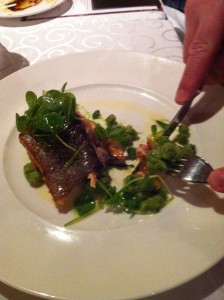 flesh and crisp of skin and topped with delicate pea shoots that I mistook for watercress. Sadly the minted peas themselves were unspectacular – the frozen kind common to Manila that can be cooked for days and still come to the table hard enough to break your teeth – and I am only ever so slightly exaggerating! We were delighted, though, to see our affable rosé return to the table, matching perfectly with the salmon.
flesh and crisp of skin and topped with delicate pea shoots that I mistook for watercress. Sadly the minted peas themselves were unspectacular – the frozen kind common to Manila that can be cooked for days and still come to the table hard enough to break your teeth – and I am only ever so slightly exaggerating! We were delighted, though, to see our affable rosé return to the table, matching perfectly with the salmon.
A primi piatti of maccheroncini (mini macaroni) was next off the ranks, coated in a rich but light truffle sauce and sprinkled with chorizo and spicy Italian sausage, leading to a lengthy discussion on whether it was flavoured with real truffles or merely truffle oil. The consensus supported the real thing. The accompanying Talamonti Moda, with its deep aroma of berries and ripe cherries has taken the silver medal in an international wine competition. Talmonti and truffle made a good match, which we topped off with freshly grated parmesan.
A slight breather was provided by an unusual orange sorbet lightly sprinkled with dark chocolate to cleanse the palate before we moved onto the main course: 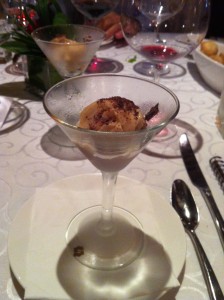 Kurobuta pork served with polenta and pecorino. I laughed at the recent fashion for ‘naming’ every ingredient on the menu: not simply pork but ‘Kurobuta Pork’, while Australian menus had been full of ‘Berkshire Pork’. Low and behold, “Kurobuta Pork is the most highly prized pork in Japan and comes from the ancient breed of pig known as Black Berkshire…regarded as the highest quality pork in the world.” Unfortunately, despite its reputation, none of us were particularly inspired by the stewed pork, which was a little stringy, but we did like the polenta, and we loved the wine! It didn’t have the strong aroma of the previous red, but this pure Montepulciano wine hit the spot. Talamonti Tre Saggi 2010 was a gold medal winner in Brussels, and it is Talamonti’s flagship red. Apparently the name means Three Wise Men, and was chosen from a fresco in a nearby church.
Kurobuta pork served with polenta and pecorino. I laughed at the recent fashion for ‘naming’ every ingredient on the menu: not simply pork but ‘Kurobuta Pork’, while Australian menus had been full of ‘Berkshire Pork’. Low and behold, “Kurobuta Pork is the most highly prized pork in Japan and comes from the ancient breed of pig known as Black Berkshire…regarded as the highest quality pork in the world.” Unfortunately, despite its reputation, none of us were particularly inspired by the stewed pork, which was a little stringy, but we did like the polenta, and we loved the wine! It didn’t have the strong aroma of the previous red, but this pure Montepulciano wine hit the spot. Talamonti Tre Saggi 2010 was a gold medal winner in Brussels, and it is Talamonti’s flagship red. Apparently the name means Three Wise Men, and was chosen from a fresco in a nearby church.
As we played about with the various wines, comparing, sipping and re-exploring, the staff cleared away the debris of dinner. We were left to our own devices for a while before the dessert made an appearance. I had hoped for a thick, creamy tiramisu – yes, I know, probably a bit plebian, but nonetheless scrumptious – but I was to be disappointed. The ricotta torta was not my cup of tea at all. Full of candied fruit (sorry, never a favourite with me) and iced with a burnt chocolate sauce, I was happy to dessert the dessert and return to the rosé and some rather delicious chocolates, and dream of balmy summer evenings on a hillside in Abruzzo. Buon Appetito!
With thanks to Google Images for the photo of Abruzzo, and, as always, to my One & Only for his photographs of the food.

Thanks for mentioned our region!
You are most welcome!